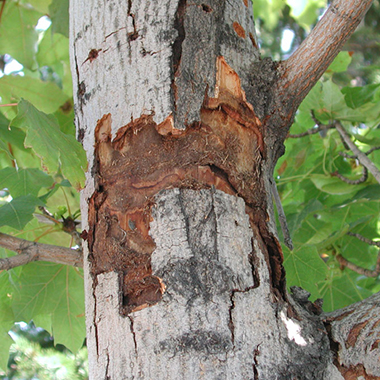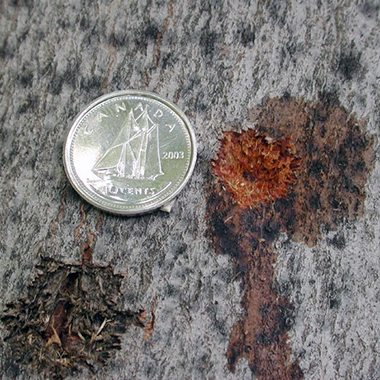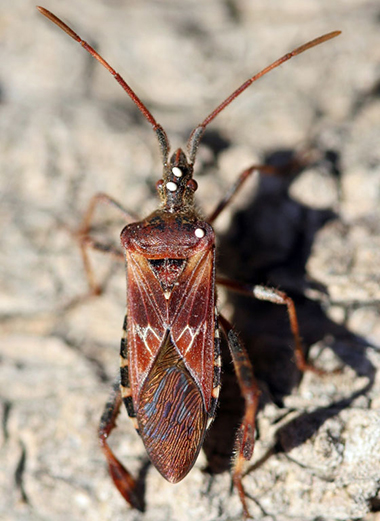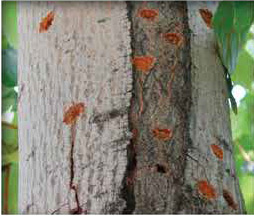On this page
- Citrus longhorned beetle and Asian longhorned beetle (legal, 8.5x14)
- Asian longhorned beetle (11.6 x 18)
- Asian longhorned beetle: bilingual (8.5 x 12.7)
Citrus longhorned beetle and Asian longhorned beetle (legal, 8.5 x 14)

Text version – Citrus longhorned beetle and Asian longhorned beetle
The citrus longhorned beetle and Asian longhorned beetle can infest and kill healthy trees. They are very similar in appearance and signs of infestation. The establishment of either of these pests could be devastating to our natural resources, including Canada's hardwood trees and forests.
Insect description
- Shiny black body with white spots
- Long antennae with black and white bands.
- 20 to 35 millimetres long
Susceptible trees
- Maple
- Birch
- Elm
- Bonsai
- Poplar
- Willow
Signs of infestation
- Round exit holes
- T-shaped slits/oviposition pit
- Sawdust-like excrement on the surface of the soil
- Galleries and tunnels under the bark (Asian long-horned beetle only)
- Foamy or frothy sap running from egg laying site
- Chewed leaves and scraped bark.
Help protect your community
- Know the source of your plants.
- Check your trees.
- Collect suspect specimens.
- Report suspect detections to the Canadian Food Inspection Agency
- Don't move firewood
Pests that can be confused for the citrus longhorned beetle and Asian longhorned beetle
- Banded alder borer
- Conifer seed bug
- Pine sawyers
Asian longhorned beetle (11.6 x 18)

Text version – Asian longhorned beetle

The Asian longhorned beetle (ALHB, Anoplophora glabripennis) is a highly destructive wood-boring pest of maples and other hardwood trees including poplar, birch and willow. ALHB infests and kills healthy trees, devastating urban and rural communities.
Adult beetles are 20–35 mm long, shiny black, with up to 20 white spots on each wing cover.
Signs and symptoms





running from recent egg laying sites.

Note teeth marks.

ALHB is native to Asia and can be introduced into Canada with infested wood packaging material (e.g. wooden pallets, crates, boxes, etc.). Once in a new environment, ALHB can disperse naturally or spread long-distance through transport of infested wood products including firewood and logs.
You can help protect your community from this invasive insect:
- check trees for evidence of ALHB
- collect suspect ALHB specimens, if found
- report suspect ALHB or ALHB tree damage to 1-800-442-2342
- don't move firewood
Not Asian longhorned beetle
Banded alder borer
- Native to BC
- Similar in size to ALHB, but flattened and has alternating transverse black and gray bands
- 20 to 35 mm long

Western conifer-seed bug
- Across Canada
- Reddish-brown to gray-brown
- Pines and leaf pattern on legs
- Up to 20 mm long

Pine sawyers
- Across Canada
- Brown or black but not shiny
- Wing covers appear pitted, not smooth like ALHB
- Smaller (18 to 27 mm) than ALHB

More information
Photo credits
- M. Bohne
- D. Cappaert
- D. Haugen (Bugwood.org)
- N. Wright
- K. Bolte
- B. Gill
- T. Poiré
- L. Schimming
- M.T. Smith
Asian longhorned beetle: bilingual (8.5 x 12.7)

Text version – Asian longhorned beetle: bilingual

The Asian longhorned beetle (ALHB) is a highly destructive wood-boring pest of maples and other hardwood trees including poplar, birch and willow. ALHB infests and kills healthy trees, devastating rural, urban and suburban communities.
Simulated signs of infestation, which show what an actual ALHB infestation may look like, have been created on this tree. Two specific signs of infestation have been used to show the typical damage caused by the ALHB in the environment (Figures 1, 2).
ALHB is native to Asia and spreads through transport of infested wood products including firewood and logs.
You can help protect your community from this invasive insect:
- check trees for evidence of ALHB
- collect possible ALHB specimens if found
- to report possible ALHB or ALHB tree damage visit plant pests and invasive species
- don't move firewood
Other signs and symptoms of this pest include:
- sawdust and wood shavings (frass)
- galleries and tunnels under the bark
- foamy or frothy sap running from egg laying sites
- thinning crowns/dead branches
- cracked or missing bark
- tree death
Figure 1

Figure 2

Figure 3
